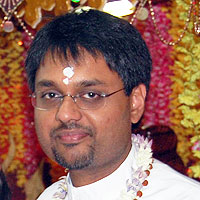Pt. Dr. Umesh Persad, Spiritual Leader, Gyaan Deepak Kirtan Mandali
At Divali, we light numerous deeyas in our homes and public spaces, which represent light and spirituality. While Lakshmi Devi is the manifestation of both material and spiritual wealth, one should be aware that most forms of material wealth tend to decrease and devalue over time whereas spiritual wealth always increases in value. These forms of spiritual wealth are control of the mind, control of the senses, withdrawal of the settled mind from the outer world, forbearance, one-pointedness of mind and faith, which combines knowledge and belief. If these deeyas are lighting within us, then we are spiritually wealthy in this life and beyond. Once we possess such spiritual wealth, we will be prepared to confront any challenges while remaining peaceful and settled in our minds.
Divali is associated with both Lakshmi Mata and Shree Ram. Ram also means light, ‘that which shines within’. If we close our eyes and visualise these deeyas lighting within us, we can ask ourselves, who is it that is looking at these lights? The answer is Bhuvaneshwari Maa, who is the space in our own consciousness. If we can settle our minds, we will experience the light, spaciousness and awareness within us that is always present. The six spiritual lights within will lead us to Shree Ram, the Supreme Light. These lights are also representations of the seven major energy centres (chakras) in the human body.
How do we prepare ourself to experience the divinity within us? This question was asked by Himalay to Devi herself in the Devi Gita. Devi, that Supreme Energy that exists in all creation and is the cause of all activity, counselled him on the pathway to liberation. She explained that there are three pathways, karma yoga (the path of action), gyaan yoga (the path of knowledge) and bhakti yoga (the path of devotion). Yoga means ‘union’ and, in a simple sense, it means union between the individual soul and the Supreme Soul. However, it must be noted that the idea of separateness between the individual and God is an illusion and our journey towards divinity is to realise that the union already exists.
Devi explains that the three pathways are actually one road with three names. There is no real difference between gyaan, bhakti and karma in that they all lead to the same destination. We all have thoughts, feelings and perform actions, but our temperaments and characters lead us to the path with which we are most comfortable. Each of us is trying to discover our true self by going beyond the restrictions of our own minds. However, Devi advises that the path of bhakti yoga is the simplest and easiest.
She tells Himalay that there are four types of bhakti:
- Tamasic bhakti: The lowest form; worshipping for the sake of harming others;
- Rajasic bhakti: Worshipping for own’s own welfare, for a desire to be fulfilled or a problem to be solved;
- Sattvic bhakti: Worshipping to purify sins and offering the results of all However, there is still a sense of separateness between the worshipper and Devi. Sattvic bhakti eventually leads to the fourth type of bhakti;
- Paraa bhakti: This is the highest form of worship; there is unity between the worshipper and the worshipped. These devotees identify with Devi Maa as their own self. It is the ultimate realisation that the one who prays and the one who listens are the same and the constant, unswerving awareness that we are much more than this limited personality.
May all devotees advance along their spiritual pathway this Divali and discover the light within our Self.
(Extracted from Sunday morning services.)



